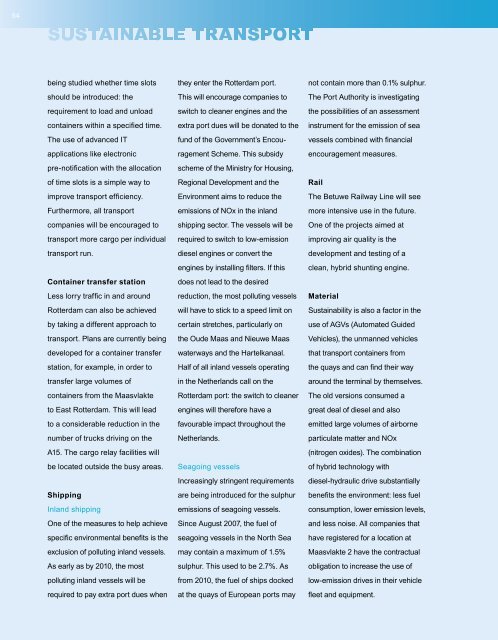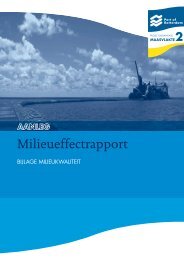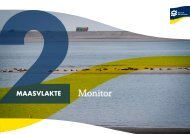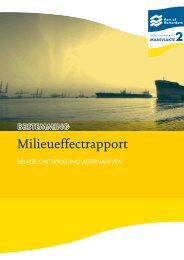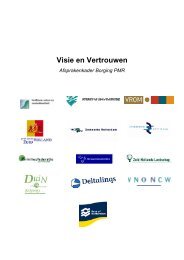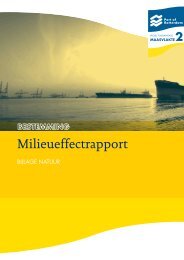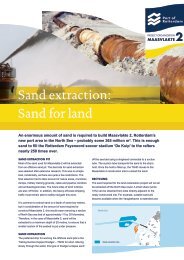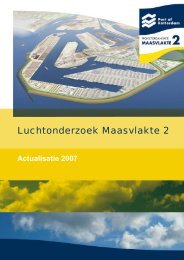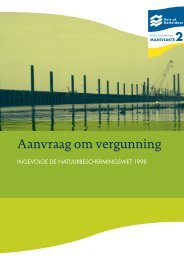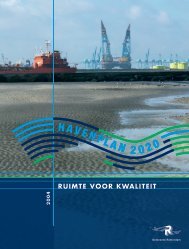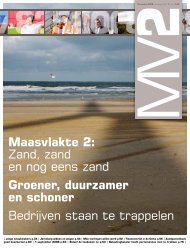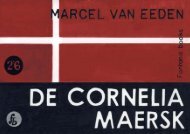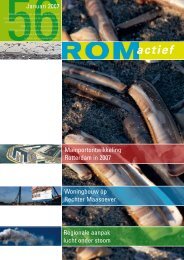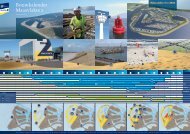Maasvlakte 2 The sustainable port (pdf, 6427Kb)
Maasvlakte 2 The sustainable port (pdf, 6427Kb)
Maasvlakte 2 The sustainable port (pdf, 6427Kb)
- No tags were found...
Create successful ePaper yourself
Turn your PDF publications into a flip-book with our unique Google optimized e-Paper software.
54being studied whether time slotsshould be introduced: therequirement to load and unloadcontainers within a specified time.<strong>The</strong> use of advanced ITapplications like electronicpre-notification with the allocationof time slots is a simple way toimprove trans<strong>port</strong> efficiency.Furthermore, all trans<strong>port</strong>companies will be encouraged totrans<strong>port</strong> more cargo per individualtrans<strong>port</strong> run.Container transfer stationLess lorry traffic in and aroundRotterdam can also be achievedby taking a different approach totrans<strong>port</strong>. Plans are currently beingdeveloped for a container transferstation, for example, in order totransfer large volumes ofcontainers from the <strong>Maasvlakte</strong>to East Rotterdam. This will leadto a considerable reduction in thenumber of trucks driving on theA15. <strong>The</strong> cargo relay facilities willbe located outside the busy areas.ShippingInland shippingOne of the measures to help achievespecific environmental benefits is theexclusion of polluting inland vessels.As early as by 2010, the mostpolluting inland vessels will berequired to pay extra <strong>port</strong> dues whenthey enter the Rotterdam <strong>port</strong>.This will encourage companies toswitch to cleaner engines and theextra <strong>port</strong> dues will be donated to thefund of the Government’s EncouragementScheme. This subsidyscheme of the Ministry for Housing,Regional Development and theEnvironment aims to reduce theemissions of NOx in the inlandshipping sector. <strong>The</strong> vessels will berequired to switch to low-emissiondiesel engines or convert theengines by installing filters. If thisdoes not lead to the desiredreduction, the most polluting vesselswill have to stick to a speed limit oncertain stretches, particularly onthe Oude Maas and Nieuwe Maaswaterways and the Hartelkanaal.Half of all inland vessels operatingin the Netherlands call on theRotterdam <strong>port</strong>: the switch to cleanerengines will therefore have afavourable impact throughout theNetherlands.Seagoing vesselsIncreasingly stringent requirementsare being introduced for the sulphuremissions of seagoing vessels.Since August 2007, the fuel ofseagoing vessels in the North Seamay contain a maximum of 1.5%sulphur. This used to be 2.7%. Asfrom 2010, the fuel of ships dockedat the quays of European <strong>port</strong>s maynot contain more than 0.1% sulphur.<strong>The</strong> Port Authority is investigatingthe possibilities of an assessmentinstrument for the emission of seavessels combined with financialencouragement measures.Rail<strong>The</strong> Betuwe Railway Line will seemore intensive use in the future.One of the projects aimed atimproving air quality is thedevelopment and testing of aclean, hybrid shunting engine.MaterialSustainability is also a factor in theuse of AGVs (Automated GuidedVehicles), the unmanned vehiclesthat trans<strong>port</strong> containers fromthe quays and can find their wayaround the terminal by themselves.<strong>The</strong> old versions consumed agreat deal of diesel and alsoemitted large volumes of airborneparticulate matter and NOx(nitrogen oxides). <strong>The</strong> combinationof hybrid technology withdiesel-hydraulic drive substantiallybenefits the environment: less fuelconsumption, lower emission levels,and less noise. All companies thathave registered for a location at<strong>Maasvlakte</strong> 2 have the contractualobligation to increase the use oflow-emission drives in their vehiclefleet and equipment.


